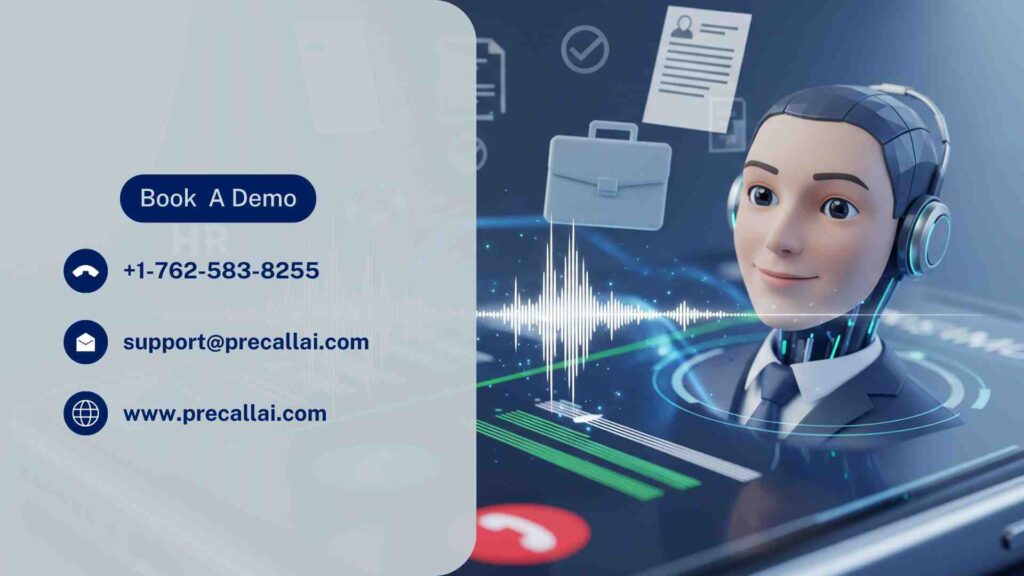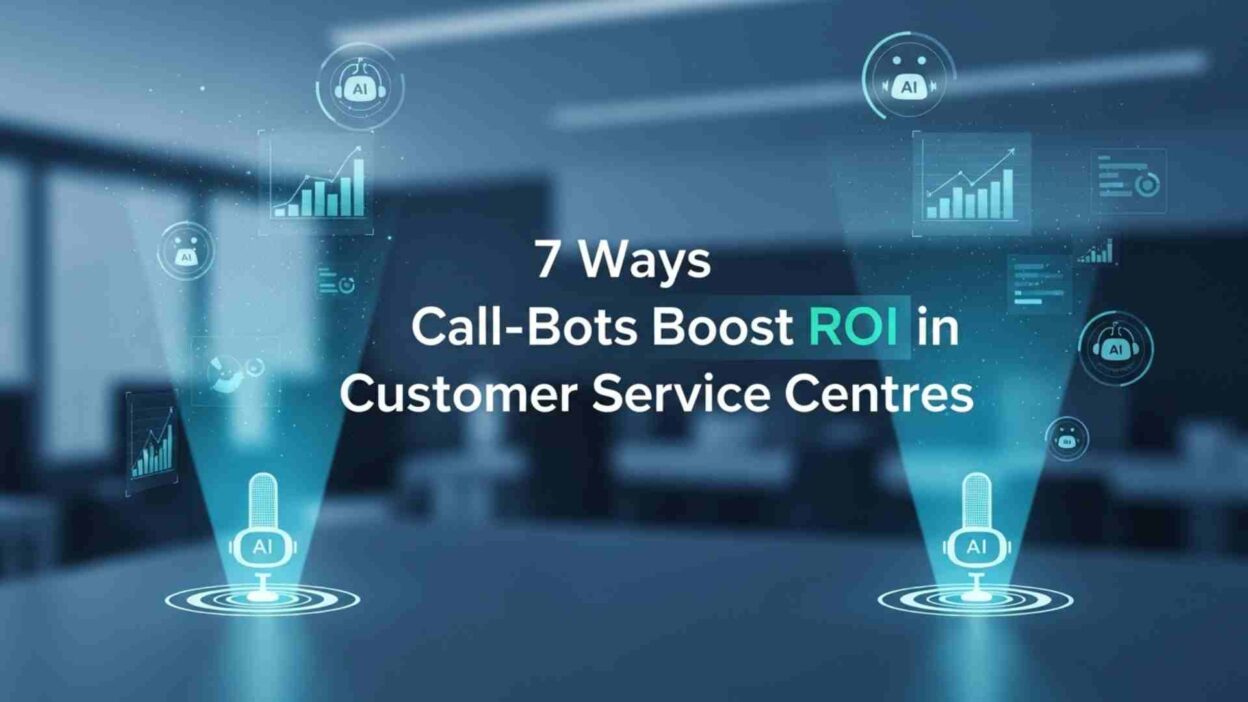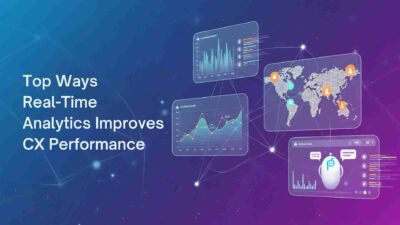Introduction
Table of Contents
TL;DR Customer service centres face mounting pressure to deliver exceptional experiences while controlling costs. Traditional call centre models struggle to balance quality service with profitability. Labor costs consume massive portions of operational budgets. Wait times frustrate customers and damage brand reputation. Service leaders search desperately for solutions that solve both problems simultaneously.
Call-bots have emerged as powerful tools for transforming customer service economics. These intelligent systems handle customer interactions with remarkable efficiency. Companies implementing call-bot technology report dramatic improvements in their bottom line. Understanding how call-bots boost ROI in customer service centres requires examining their multifaceted impact. The financial benefits extend far beyond simple cost reduction. Strategic deployment creates competitive advantages that compound over time.
Modern call-bots leverage artificial intelligence to understand customer needs. They respond naturally to spoken questions and requests. The technology has matured beyond rigid scripted responses. Today’s systems learn from every interaction they process. Service centres that embrace this technology position themselves for sustainable profitability.
Reducing Labor Costs Through Automated Call Handling
Labor expenses represent the largest cost category for most service centres. Agent salaries, benefits, and training create substantial ongoing expenses. Traditional models require staffing for peak call volumes. This approach leads to expensive overstaffing during slower periods. Call-bots eliminate this inefficiency by handling volume fluctuations seamlessly.
Automated systems manage routine inquiries without human intervention. Simple questions about hours, locations, or account balances get resolved instantly. Password resets and basic troubleshooting happen through conversational interfaces. These interactions represent 60-70% of typical call centre volume. Automating them frees human agents for complex issues requiring judgment and empathy.
The math behind labor cost reduction proves compelling quickly. A single call-bot can handle thousands of simultaneous conversations. Human agents manage only one call at a time. The cost per interaction drops from dollars to pennies. Service centres calculate payback periods measured in months rather than years.
Calculating Direct Savings from Call-Bot Implementation
Organizations measure savings by comparing pre and post-implementation metrics. Average handle time for routine calls decreases by 80% or more. Agent headcount requirements drop as call-bots absorb volume. Overtime expenses virtually disappear when automation handles overflow. The financial impact appears immediately in operational reports.
Real-world examples demonstrate the scale of potential savings. A mid-sized insurance company reduced agent staff by 40% after deploying call-bots. Their annual labor cost decreased by $2.3 million. Customer satisfaction scores improved despite fewer human agents. This combination of better service and lower costs defines how call-bots boost ROI in customer service centres.
Benefit costs decrease proportionally with reduced headcount needs. Healthcare coverage, retirement contributions, and other perks add 30-40% to base salaries. Call-bots require no benefits or time off. They work continuously without breaks or vacations. The cumulative savings over multiple years reach millions for enterprise operations.
Optimizing Staffing Models with Predictable Automation
Workforce management becomes dramatically simpler with call-bot deployment. Managers no longer stress about unpredictable call volume spikes. Automated systems scale instantly to meet demand surges. Human agents focus exclusively on calls requiring their expertise. This specialization improves both efficiency and job satisfaction.
Peak period staffing challenges diminish significantly with automation support. Holiday seasons and promotional campaigns create massive volume increases. Traditional centres hire temporary staff at premium rates. Call-bots handle these surges without additional recruitment expenses. The operational flexibility provides strategic advantages during crucial business periods.
Training costs drop when new agents focus on complex scenarios only. New hires learn specialized skills rather than basic procedures. Onboarding time shortens from weeks to days. The quality of human interactions improves as agents develop deeper expertise. Organizations achieve more with fewer people through intelligent automation.
Increasing Customer Service Capacity Without Infrastructure Expansion
Physical infrastructure limits traditional call centre growth. Adding capacity requires office space, equipment, and telecommunications systems. Real estate costs in urban centres continue climbing. Equipment procurement involves lengthy approval and installation processes. These capital expenditures create barriers to rapid scaling.
Call-bots eliminate physical infrastructure constraints entirely. Cloud-based systems deploy globally without geographic limitations. Capacity increases happen through software configuration rather than construction. Service centres handle 10x volume increases without physical expansion. This scalability transforms service economics fundamentally.
Technology infrastructure costs remain predictable and manageable. Cloud pricing scales with actual usage rather than peak capacity. Organizations pay only for active conversations processed. Idle capacity costs nothing during slow periods. This usage-based model aligns expenses with business results perfectly.
Serving Global Markets Without Geographic Expansion
International expansion becomes affordable through call-bot deployment. Companies serve customers worldwide without establishing foreign offices. Language capabilities expand through software updates rather than multilingual hiring. Time zone coverage happens automatically with always-available automation. The global reach once reserved for large enterprises becomes accessible to smaller organizations.
Market entry speeds accelerate dramatically with automated customer service. New product launches happen without months of call centre preparation. Geographic expansion occurs without the risk of stranded infrastructure investments. Business agility increases as service capabilities decouple from physical constraints. Strategic opportunities get captured that would otherwise be impossible.
Seasonal businesses benefit enormously from elastic capacity models. Retailers handle holiday volume without permanent infrastructure overhead. Tax preparation services scale up during filing season effortlessly. Event-based businesses serve customers during concentrated demand periods. Understanding how call-bots boost ROI in customer service centres includes recognizing this flexibility value.
Managing Volume Spikes Without Performance Degradation
Traditional centres struggle when call volumes exceed capacity. Customers endure long hold times during peak periods. Service quality deteriorates under pressure. Abandoned calls represent lost revenue and damaged relationships. These capacity failures create lasting negative impacts on business results.
Call-bots maintain consistent performance regardless of volume levels. Response times remain instant whether handling ten or ten thousand calls. Customer experience stays uniformly excellent across all demand scenarios. This reliability builds trust and brand loyalty. Customers learn they can depend on responsive service anytime.
Disaster recovery and business continuity improve with distributed automation. Natural disasters or local outages no longer cripple customer service operations. Call-bots operate from multiple data centres with automatic failover. Service continuity protects revenue during critical situations. The risk profile of customer service operations improves dramatically.
Extending Service Hours to 24/7 Availability
After-hours service represents a massive opportunity for revenue protection and growth. Customers expect help when they need it regardless of time. Traditional business hours leave customers stranded during evenings and weekends. Competitors offering better availability steal market share. The cost of 24/7 human staffing prohibits most organizations from competing effectively.
Call-bots provide round-the-clock service without premium labor costs. Customers receive immediate assistance at 3 AM as easily as 3 PM. Night shift differentials and weekend premiums disappear from budget calculations. Service quality remains consistent across all hours. This always-on availability transforms customer relationships fundamentally.
Global businesses particularly benefit from timezone-independent service delivery. Customers in Asia receive excellent support during their business hours. European customers get help during their mornings. North American customers find assistance whenever needed. A single automated system serves all regions simultaneously.
Capturing Revenue That Would Otherwise Be Lost
Purchase decisions often happen outside traditional business hours. Customers researching products at night need immediate answers. Technical issues preventing service usage create urgent support needs. Without immediate help available, customers abandon transactions or switch providers. These lost opportunities represent substantial revenue leakage.
Call-bots capture revenue by being available during decision moments. Pre-sales questions get answered instantly at any hour. Purchase barriers get removed before customers lose interest. Account issues get resolved before frustration drives churn. The revenue protection value often exceeds direct cost savings.
Subscription businesses reduce churn through continuous support availability. Customers considering cancellation can address issues immediately. Problems get resolved before reaching critical frustration levels. Retention rates improve measurably with always-available assistance. The lifetime value of customers increases as churn decreases.
Improving Customer Satisfaction Through Immediate Response
Customer patience has decreased as technology enables instant gratification. Waiting until business hours for simple answers feels unacceptable. Social media amplifies negative experiences shared by frustrated customers. Service expectations have shifted permanently toward immediate availability. Organizations unable to meet these expectations lose customers to competitors.
Call-bots deliver the instant gratification modern customers demand. Questions receive answers in seconds rather than hours or days. Problems get acknowledged immediately even if resolution requires human follow-up. The psychological impact of instant response dramatically improves satisfaction. Customers feel valued when help arrives immediately upon request.
Survey data confirms the satisfaction impact of extended availability. Net Promoter Scores increase significantly after implementing 24/7 automation. Customer effort scores improve as self-service becomes effortless. These metrics correlate directly with revenue retention and growth. Discovering how call-bots boost ROI in customer service centres means recognizing satisfaction’s financial value.
Improving First-Call Resolution Rates
First-call resolution represents a critical efficiency metric for service operations. Repeat calls for the same issue waste resources and frustrate customers. Complex escalation procedures consume time from multiple agents. Poor knowledge management creates inconsistent answers to common questions. These inefficiencies multiply costs while damaging customer relationships.
Call-bots access comprehensive knowledge bases instantly and consistently. They never forget procedures or policies. Information retrieval happens in milliseconds. Answers remain accurate regardless of call volume or complexity. This consistency eliminates the variability that plagues human-only operations.
Pattern recognition capabilities allow call-bots to diagnose issues efficiently. They ask targeted questions to understand problems quickly. Solutions get matched to symptoms using sophisticated algorithms. Troubleshooting happens systematically rather than through trial and error. Resolution times decrease while success rates increase.
Reducing Repeat Calls Through Comprehensive Resolution
Incomplete resolutions force customers to call back repeatedly. Each additional call doubles or triples the cost of service delivery. Customer frustration grows with each repeated contact. The compounding inefficiency devastates operational economics. Organizations must break this cycle to achieve sustainable profitability.
Call-bots follow structured resolution processes that ensure completeness. They confirm successful resolution before ending interactions. Follow-up information gets delivered automatically through preferred channels. Customers receive everything needed to stay resolved. The repeat call rate drops by 50% or more with proper implementation.
Predictive analytics identify likely follow-up needs before customers recognize them. Proactive information delivery prevents future contacts. Customers receive guidance on potential next steps. This anticipatory service approach creates delightful experiences. The reduction in inbound volume provides substantial cost benefits.
Leveraging Machine Learning for Continuous Improvement
Call-bots learn from every interaction they process. Successful resolution patterns get reinforced automatically. Unsuccessful approaches get identified and refined. The system becomes more effective with each conversation. This continuous improvement happens without manual intervention or retraining costs.
Knowledge gaps surface through interaction analysis. Frequently asked questions without good answers get flagged. New procedures get incorporated into call-bot responses immediately. The knowledge base stays current without extensive maintenance overhead. Organizations gain institutional learning that compounds over time.
Performance analytics reveal optimization opportunities systematically. Conversation flow analysis identifies friction points. Customer sentiment tracking highlights areas needing improvement. These insights drive targeted enhancements with measurable results. The ROI of call-bots increases steadily as systems mature through learning.
Collecting Valuable Customer Data and Insights
Customer service interactions contain rich information about needs and preferences. Traditional centres capture minimal data from conversations. Valuable insights get lost when agents move to the next call. Organizations make decisions with incomplete understanding of customer sentiment. This information gap leads to suboptimal strategies and missed opportunities.
Call-bots record and analyze every conversation comprehensively. Structured data extraction happens automatically during interactions. Patterns emerge from analyzing thousands of conversations. Business intelligence flows naturally from service operations. The strategic value of these insights often exceeds direct operational savings.
Customer sentiment analysis provides real-time feedback on products and services. Frustration indicators alert teams to emerging issues. Satisfaction patterns identify successful initiatives worth expanding. This continuous feedback loop enables agile business responses. Organizations become more customer-centric through data-driven decision making.
Identifying Product Issues and Improvement Opportunities
Support conversation analysis reveals product problems quickly. Specific features generating confusion or complaints surface immediately. Technical issues affecting multiple customers get detected early. This early warning system prevents small problems from becoming crises. Product teams receive actionable feedback for prioritizing improvements.
Feature requests and enhancement ideas emerge from customer conversations. Patterns in desired functionality guide development roadmaps. Competitive intelligence surfaces through comparison mentions. Market needs become clear through aggregated customer input. Innovation happens faster when grounded in actual customer requirements.
Quality control improves through systematic conversation analysis. Service delivery problems get identified before becoming widespread. Agent performance issues surface through objective metrics. Process breakdowns reveal opportunities for operational refinement. Understanding how call-bots boost ROI in customer service centres includes recognizing these quality benefits.
Personalizing Customer Experiences Through Data Utilization
Customer interaction history enables personalized service delivery. Call-bots recognize returning customers immediately. Previous conversations inform current interactions. Preferences get remembered and applied automatically. This personalization creates memorable experiences that build loyalty.
Segmentation opportunities reveal themselves through conversation pattern analysis. Different customer types exhibit distinct behavior signatures. Service approaches get tailored to segment preferences. Marketing campaigns target audiences with proven messaging. The granular understanding of customers drives revenue growth across functions.
Predictive modeling forecasts customer needs before explicit requests occur. Lifecycle stage indicators trigger proactive outreach. Churn risk scores enable retention interventions. Cross-sell and upsell opportunities get identified systematically. The commercial value of customer data insights justifies automation investment independently.
Reducing Training Costs and Improving Agent Effectiveness
Agent training represents a significant ongoing expense for service centres. New hire onboarding takes weeks of classroom instruction. Product knowledge requires constant updating as offerings evolve. Quality assurance monitoring consumes supervisor time. Turnover forces constant recruitment and training cycles. These human capital costs substantially impact profitability.
Call-bots handle routine inquiries that require minimal training complexity. New agents focus exclusively on complex scenarios from day one. Specialized expertise develops faster with concentrated experience. Training curricula shrink to cover only advanced topics. The time and cost of bringing agents to productivity drops dramatically.
Quality consistency improves when automation handles standardized interactions. Call-bots never have bad days or forget procedures. Compliance requirements get met perfectly every time. Brand messaging stays consistent across all automated interactions. The reduction in quality defects saves money and protects reputation.
Supporting Agents with Real-Time Assistance
Human agents benefit from call-bot assistance during complex calls. Knowledge base searches happen automatically based on conversation context. Relevant information appears to agents without breaking conversation flow. Decision support guides agents through intricate scenarios. This augmentation makes every agent more effective.
New agents perform like veterans with automated support systems. Confidence increases when comprehensive guidance is always available. The experience gap between new and experienced agents narrows significantly. Service quality stays high regardless of tenure. Organizations reduce their dependence on expensive senior agents.
Supervisor escalations decrease when agents have better support tools. Questions get answered immediately without interrupting workflows. Edge cases get handled through automated decision trees. The need for supervisory intervention drops by 60% or more. Management capacity focuses on coaching rather than constant troubleshooting.
Decreasing Turnover Through Improved Job Satisfaction
Agent burnout stems largely from monotonous routine call handling. Answering the same basic questions hundreds of times daily drains motivation. Call-bots eliminate this soul-crushing repetition from agent responsibilities. Humans handle only interesting complex problems. Job satisfaction increases dramatically with enriched responsibilities.
Career development opportunities expand when agents develop specialized expertise. Technical specialists, conflict resolution experts, and relationship managers emerge. Professional growth paths become clearer and more attractive. Turnover rates decrease as jobs become more fulfilling. Recruitment costs drop as retention improves.
The financial impact of reduced turnover compounds across multiple dimensions. Recruitment advertising expenses decrease substantially. Training costs per agent spread across longer tenures. Institutional knowledge accumulates rather than constantly draining away. Team cohesion and performance improve with stable workforces. Recognizing how call-bots boost ROI in customer service centres requires valuing these retention benefits.
Scaling Service Operations Without Proportional Cost Increases
Traditional service centre scaling follows linear or worse cost curves. Doubling call volume typically requires doubling agent headcount. Physical infrastructure expands proportionally with capacity needs. Management layers multiply to maintain span of control. Growth becomes increasingly expensive as organizations scale.
Call-bots break this linear relationship between volume and cost. A system handling 10,000 calls monthly scales to 100,000 with minimal cost increase. Marginal costs approach zero for additional conversations. This economic model fundamentally changes growth dynamics. Profitability improves as volume increases rather than degrading.
Market share gains become affordable when service costs scale sublinearly. Aggressive growth strategies work financially with automation support. Customer acquisition costs remain viable at higher volumes. Competitive pricing becomes sustainable with superior cost structures. Strategic options expand dramatically with better unit economics.
Achieving Economies of Scale Through Automation
Fixed costs get spread across larger volumes as automation handles growth. Technology infrastructure costs remain relatively constant regardless of usage levels. Development expenses for call-bot capabilities amortize across expanding customer bases. Per-interaction costs plummet as volume increases. This scale advantage creates powerful competitive moats.
Multi-brand and multi-product support happens within unified platforms. Organizations serve diverse offerings without proportionally increasing costs. Acquisitions integrate smoothly into existing automation infrastructure. Portfolio expansion happens without linear service cost increases. The strategic flexibility enables inorganic growth strategies.
Geographic expansion follows similar favorable economics. International markets get served without establishing local operations. Language capabilities deploy through software rather than hiring. Regulatory compliance gets programmed once and applied everywhere. Global ambitions become financially viable for organizations of all sizes.
Maintaining Service Quality While Growing Rapidly
Rapid growth traditionally degrades service quality as organizations strain capacity. Hiring and training lag behind volume increases. Inexperienced agents handle calls before adequate preparation. Customer satisfaction suffers during expansion phases. This quality degradation limits sustainable growth rates.
Call-bots maintain consistent quality regardless of growth speed. Performance stays excellent whether serving 100 or 100,000 customers. New market launches happen without service quality risks. Customers receive identical excellent experiences in all geographies. The decoupling of quality from growth rate enables aggressive expansion.
Brand reputation protection improves with automation consistency. Service failures no longer accompany market expansion. Customer acquisition happens without the risk of disappointing new customers. Market entries succeed at higher rates with reliable service delivery. Understanding how call-bots boost ROI in customer service centres includes appreciating this growth enablement value.
Implementing Call-Bots for Maximum ROI Impact
Strategic planning determines implementation success and ROI realization speed. Organizations assess current operations to identify highest-impact opportunities. They prioritize use cases based on volume and complexity characteristics. Phased rollouts minimize risk while building organizational confidence. Early wins build momentum for broader adoption.
Technology selection requires evaluating capabilities against specific business needs. Natural language understanding quality varies significantly across platforms. Integration capabilities determine deployment complexity and timeline. Customization flexibility affects long-term adaptability. Vendor stability and support quality impact sustained success.
Change management deserves equal attention to technology selection. Customer communication prepares users for new service channels. Agent training ensures smooth collaboration between humans and automation. Performance metrics track progress and identify improvement opportunities. Leadership commitment sustains initiatives through inevitable challenges.
Measuring and Optimizing ROI Over Time
Baseline metrics establish starting points for ROI calculations. Current cost per interaction, resolution rates, and satisfaction scores get documented. Volume patterns and seasonal variations get characterized thoroughly. This foundation enables accurate impact measurement post-implementation.
Continuous monitoring tracks performance against expectations. Call volume distribution between automation and humans reveals adoption patterns. Customer satisfaction measurements ensure quality maintenance during transition. Cost tracking confirms financial benefits materialize as projected. Regular reviews identify optimization opportunities.
Iterative improvement cycles maximize long-term value realization. Conversation analysis reveals gaps in automated capabilities. New use cases emerge as technology and confidence grow. Integration deepens as initial implementations prove valuable. The ROI of call-bots increases steadily through systematic enhancement.
Avoiding Common Implementation Pitfalls
Poor conversation design creates frustrating customer experiences. Overly complex menus confuse rather than help. Insufficient natural language understanding leads to misinterpretations. These design failures undermine adoption and ROI. Professional conversation designers should guide implementation efforts.
Inadequate integration with backend systems limits automation effectiveness. Call-bots need real-time access to customer and transaction data. Authentication and verification must work seamlessly. Order status and account information must be current and accurate. Technical integration quality directly determines business value delivered.
Neglecting ongoing maintenance degrades performance over time. Knowledge bases become outdated without systematic updates. New products and policies need incorporation into automated responses. Performance monitoring must continue after initial deployment. Organizations treating implementation as one-time projects fail to sustain benefits.
✅ Frequently Asked Questions
About Call-Bot ROI
⏱️ How Quickly Can Organizations See ROI from Call-Bot Implementation?
Most organizations observe measurable benefits within the first three months.
Labor cost reductions appear immediately as automation absorbs call volume.
Customer satisfaction improvements surface in monthly survey results.
Full financial payback typically occurs within 12–18 months.
Enterprise implementations with broader scope may require longer timelines.
The investment in how call-bots boost ROI in customer service centres delivers returns reliably.
📞 What Percentage of Calls Can Call-Bots Handle Effectively?
Well-designed call-bot systems successfully resolve 60–80% of incoming calls.
Simple informational queries achieve near-perfect automation rates.
Routine transactions like password resets work excellently through automation.
Complex problem-solving and emotional situations still require human agents.
The automation percentage increases over time as systems learn and improve.
👥 Do Customers Prefer Call-Bots or Human Agents?
Customer preferences depend heavily on interaction complexity and quality.
For simple, quick questions, customers overwhelmingly prefer instant automated responses.
Complex issues requiring judgment benefit from human expertise and empathy.
Quality implementation matters more than human versus automated distinction.
Customers value speed, accuracy, and convenience regardless of delivery method.
💰 How Much Do Call-Bot Systems Cost to Implement?
Implementation costs vary widely based on scope and complexity.
Small deployments start around $50,000 for basic capabilities.
Enterprise implementations range from $200,000 to $1M+.
Ongoing subscription costs typically range from $10,000–$100,000 monthly.
The specific investment depends on call volume, integration complexity, and customization needs.
🌍 Can Call-Bots Handle Multiple Languages Effectively?
Modern call-bot platforms support dozens of languages with strong accuracy.
Major languages like Spanish, French, and German work excellently.
Dialect variations get handled through regional training.
Translation quality affects customer experience significantly in multilingual deployments.
Organizations should verify specific language support aligns with customer needs.
🔄 What Happens When Call-Bots Cannot Resolve Customer Issues?
Seamless escalation to human agents preserves customer experience.
Context from automated conversations transfers fully to human agents.
Customers avoid repeating information during escalation.
Queue prioritization can fast-track escalated calls for immediate attention.
Hybrid models combining automation and human expertise deliver optimal results.
Read More:-Why Compliance Call Verification Tools Matter
Conclusion

The financial impact of call-bots on service centre operations proves substantial and multifaceted. Direct labor cost reductions provide immediate visible benefits. Capacity expansion without infrastructure investment enables strategic growth. Extended service hours capture revenue that would otherwise disappear. These benefits combine to transform service economics fundamentally.
Operational improvements compound financial gains over time. First-call resolution rates increase while repeat contacts decrease. Training costs drop as agent responsibilities focus on complex scenarios. Data insights drive better business decisions across organizations. The total value exceeds what simple cost reduction calculations suggest.
Understanding how call-bots boost ROI in customer service centres requires examining both short and long-term impacts. Immediate savings justify investment through rapid payback. Strategic advantages position organizations for sustained competitive success. Customer satisfaction improvements protect and grow revenue. The combination creates compelling business cases across industries.
Implementation success depends on thoughtful planning and execution. Technology selection must match business requirements precisely. Change management ensures smooth adoption by customers and staff. Continuous optimization maximizes value realization over time. Organizations approaching deployment strategically achieve superior results.






[…] Read More:-7 Ways Call-Bots Boost ROI in Customer Service Centres […]